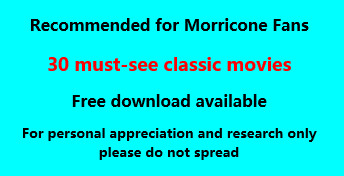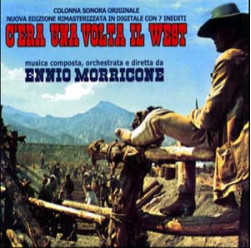ONCE UPON A TIME IN THE WEST (1968)
Arguably one of the greatest westerns ever made, Sergio Leone’s Once Upon a Time in the West – C’Era Una Volta Il West in his native Italian – was his eagerly awaited, and ultimately critically acclaimed follow up to the Clint Eastwood “Dollars” trilogy that he completed with The Good the Bad and the Ugly in 1966. It’s a tale of murder, death, betrayal, and revenge, and focuses on three individuals: Frank, played against type by Henry Fonda; Jill, played by Claudia Cardinale; and a man with no name, played by Charles Bronson, whose defining feature is that he plays the harmonica. Frank is a gunslinger, who has just killed an entire family so that he and his gang can take over the land and exploit the railroad, which is intended to be built nearby. Jill is the new wife of the man who Frank has just killed, and has arrived in town to be with him – only to find her life in ruins thanks to Frank’s ruthlessness. Meanwhile, Harmonica has a vendetta against Frank that goes back years, and intends to exact revenge in any way he can. The film also stars Jason Robards as Cheyenne, another local gunman, and features Gabriele Ferzetti, Woody Strode, Jack Elam, and Lionel Stander in supporting roles. It has a screenplay by Leone, Bernardo Bertolucci, and Dario Argento – a holy triumvirate of Italian filmmaking talent if ever there was one – and of course features one of Morricone’s most beloved scores.
Leone had Morricone compose the score before shooting started, and played the music in the background for the actors on set to inspire them – and What an inspiration that must have been! The score is based around four main themes for the four main characters, as well as an overarching theme for the film as a whole, and several spectacular one-off set pieces that underscore the violence and betrayal at the heart of the story.
Jill’s theme is the most famous, a glorious and soaring melody that rises from a soft and gentle duet for dulcimer and flute to incorporate a wordless solo soprano by the incomparable Edda dell'Orso,, and eventually the full orchestra. It’s a theme of great fragility and beautify, but is also underpinned by a strength and determination that captures her character perfectly; its performances in the opening “C’Era Una Volta Il West,” the sweeping “Arrivo Alla Stazione,” the wistful “L’America di Jill,” the peaceful “Un Letto Troppo Grande,” the sad, almost lost-sounding “In Una Stanza Con Poca Luce,” and the operatic “Finale” remain among the best things Morricone ever wrote, and that’s saying a lot.
Frank’s theme is, naturally, the most sparse and restrained, a tight and uncomfortable melody that uses a repetitive electric guitar motif alongside a harpsichord to convey his brutal, single-minded ruthlessness. It first appears in “L’Uomo,” and then grows to near-operatic heights of tragedy in “Il Grande Massacro,” when Frank and his gang calmly slaughter the entire McCain family in a scene filled with gratuitous slow-motion and uneasy close-ups. Later statements in the regretful, bittersweet “Epilogo” also leave positive impressions.
Harmonica’s theme, as one might expect, is built around that instrument in combination with undulating strings and an electric guitar, but Alessandro Alessandrini's performance of it is sparse, dissonant, and antagonistic, the flip side to the romantic American west. The harmonica performances bookend a remarkable middle section for choir and orchestra. The theme is most prominent, naturally, in “Armonica,” in “L’Ultimo Rantolo,” and of course in the standout “L’Uomo dell’Armonica,” where the voices really soar.
Finally, Cheyenne’s theme has an almost comedic edge, with percussion items that mimic the hoofbeats of a horse, accompanying a plucky banjo tune. Cues like “La Posada 1,” the eponymous “Cheyenne,” “Sul Tetto del Treno,” and “Addio a Cheyenne” feature Cheyenne’s theme prominently, but Morricone is careful to never let the music – or the character – turn into parody, instead adding a level of uneasiness with minor key strings and frequent glittering harpsicord notes.
While the highlights of The Good the Bad and the Ugly are arguable superior, Once Upon a Time in the West is probably a more well-rounded overall score, and as such it is always in the conversation regarding best western scores, best spaghetti western scores, and the best scores of Morricone’s career. It’s certainly an absolutely vital work that belongs in every self-respecting fan’s collection. The score has, naturally, been released dozens and dozens of times over the years, on alums of varying length and varying sound quality. I have chosen to review the 2014 2-CD limited edition release of the score from GDM/Intermezzo Media, which pairs over an hour of score from this film with almost 40 minutes of music from that other legendary work, A Fistful of Dollars.
Track Listing: 1. C’Era Una Volta Il West (3:43), 2. L’Uomo (1:03), 3. Il Grande Massacro (2:40), 4. Arrivo Alla Stazione (0:55), 5. L’Orchestraccia (2:25), 6. L’America di Jill (2:47), 7. Armonica (2:27), 8. La Posada 1 (1:39), 9. Un Letto Troppo Grande (1:32), 10. Jill (1:47), 11. Frank (1:52), 12. Cheyenne (1:16), 13. La Posada 2 (1:33), 14. La Posada 3 (1:19), 15. Epilogo (1:14), 16. Sul Tetto del Treno (1:19), 17. L’Uomo dell’Armonica (3:30), 18. In Una Stanza Con Poca Luce (5:08), 19. L’Attentato (4:41), 20. Ritorno al Treno (0:57), 21. Morton (1:36), 22. Come Una Sentenza (3:08), 23. Duello Finale (3:35), 24. L’Ultimo Rantolo (1:44), 25. Nascita di Una Città (4:25), 26. Addio a Cheyenne (2:38), 27. Finale (4:00). GDM/Intermezzo Media Records GDM 00804, 64 minutes 52 seconds.












